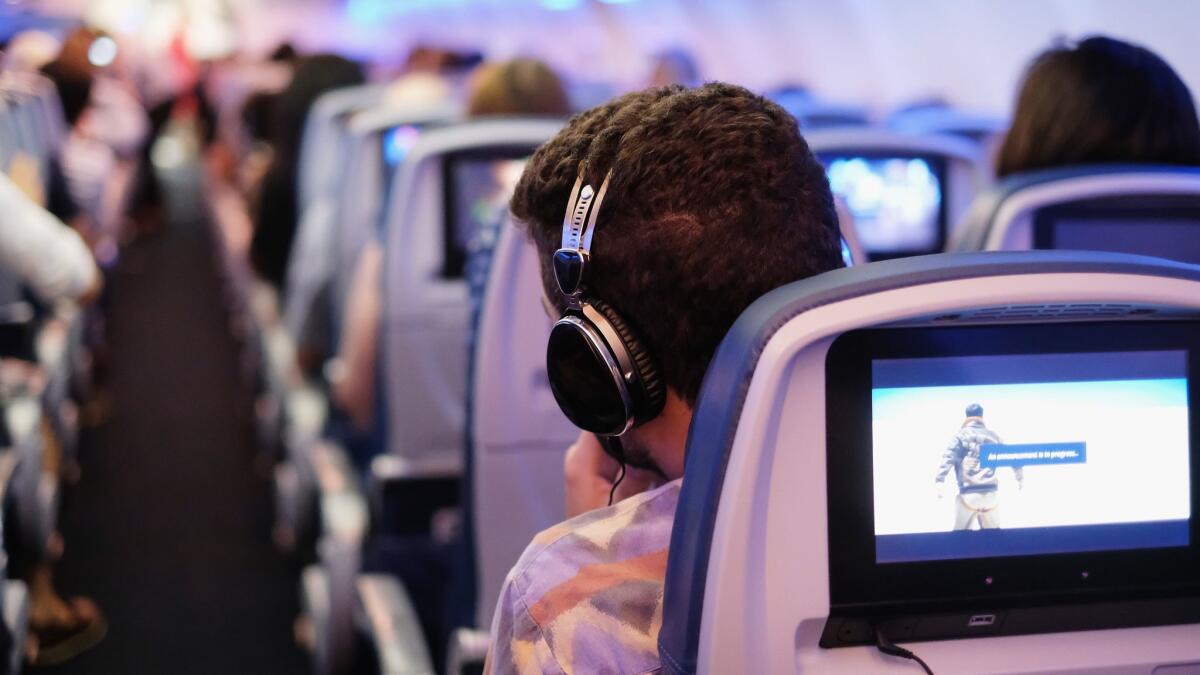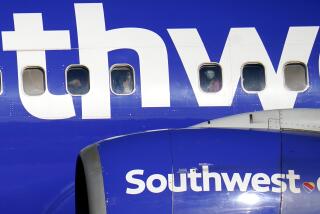The future of in-flight entertainment is up in the air

- Share via
Question: I recently flew from Barcelona, Spain, to Los Angeles on two flights. I was surprised that there were no individual seat-back screens available to distract us with movies or programs. We were expected to watch movies on our tiny cellphones (or tablets), using a downloaded app for the combined 13 hours in the air. This was quite a surprise. Only 18 months before, another airline had provided seat-back screens. Hope this is not a trend.
Sherry Runyon
South Pasadena
Answer: Runyon has seen the future, and it’s … confusing, because the consistency of the experience, never mind the quality of it, varies wildly.
My own recent experience baffled me. On June 1, I flew a red-eye from LAX to Washington Dulles on a major airline. My coach seat was cozy (ahem), but I was distracted (easily) by seat-back entertainment, which was stocked with fairly current movies, including “Black Panther” and others that still had an Oscar glow about them.
On the morning of June 4, I flew back to LAX from Dulles. This time, the upgrade gods had granted my wish. There I was in first class where (for 15,000 points and $75) drinks were offered before takeoff, a meal and snacks were served and pleasantries were exchanged.
Perhaps most surprising, though, was that despite this sort of genteel atmosphere, there were four smallish overhead screens for the 24 of us to share.
An announcement before takeoff advised us to download the airline app to see what else was available to enjoy. If not, our choice for the first 160 minutes of our flight was the movie “Molly’s Game,” which I had seen. Instead, I worked a little and dozed a little, waking up in time to see the movie’s federal judge mouth (because I didn’t have earbuds in) the sentence conferred on Bloom, whose high-stakes poker games were a gamble that went bad.
Sort of like in-flight entertainment, which is many things any organization dislikes: It’s expensive, it can be inefficient and unreliable, and it can be a waste of space.
To add insult, passengers don’t always like it.
In the most recent J.D. Power survey of airline satisfaction, released last month, the 11,508 respondents were happier than ever with what’s going on with airlines — except when it comes to “in-flight services,” which includes in-flight entertainment.
Passengers favor seat-back screens, said Michael Taylor, the practice lead for travel for J.D. Power, and are less enamored of PEDs — personal entertainment devices — which you know as your cellphone or tablet.
Why is this our problem?
Why put the onus on passengers to connect to the entertainment offerings? “The airlines studied this and [most] passengers are carrying” a phone or tablet, Taylor said. Which means the airlines don’t have to buy the hardware.
The second advantage to BYOS (bring your own screens): Those seat-back screens and wiring add to the weight of the plane, and weight reduces fuel efficiency, especially important as fuel prices have begun to climb.
The third advantage to BYOS: If your seat must provide the framework for a clunky screen, you can’t make seats smaller and thinner, which means you can’t get more seats into an airplane, sell more tickets and make more money.
But we don’t always have to bring our own, as I discovered last week. Why would I get a lovely seat-back screen on one flight and none on the next? Probably because many airlines use several kinds of aircraft and the age of those aircraft varies, Taylor said. An older plane may have a first-generation entertainment system; a newer one might have better hardware…or none at all.
Is this really a problem?
Fretting about entertainment choices may seem like wasted energy, but it can help differentiate one airline from another, said Samuel Engel, senior vice president at ICF, an aviation consulting business.
The systems, if they’re good, seem to confer a competitive edge.
“For quite some time, airlines didn’t have a choice” in whether they needed to provide entertainment; they needed it for customer satisfaction.
“Now they have a choice, and that choice allows them to save money, not just in the investment but also the maintenance and refurbishment” of that equipment, Engel said.
In the early days, when the system broke, airlines sometimes handed out vouchers, another expense, to try to soothe entertainment-starved passengers.
Some of the systems are still balky and cause more pain than pleasure. But Engel remains hopeful that tech issues can be sorted out.
After all, he said, “It’s 2018, and Amazon has already delivered your product to you before you’ve even ordered it.”
Keeping up with the airline Joneses is important, because customers’ expectations haven’t decreased, especially among those for whom entertainment isn’t a privilege but a right.
Until these issues are sorted you, you don’t leave home without your PED, a.k.a. the smartphone or the tablet.
If you do forget one or the other of those digital darlings, there’s something called a book that’s just as portable as a PED and has been entertaining and expanding minds since about the 15th century, far longer that the current life expectancy of in-flight entertainment hardware.
Have a travel question or dilemma? Write to travel@latimes.com. We regret we cannot answer every inquiry.
More to Read
Sign up for The Wild
We’ll help you find the best places to hike, bike and run, as well as the perfect silent spots for meditation and yoga.
You may occasionally receive promotional content from the Los Angeles Times.







